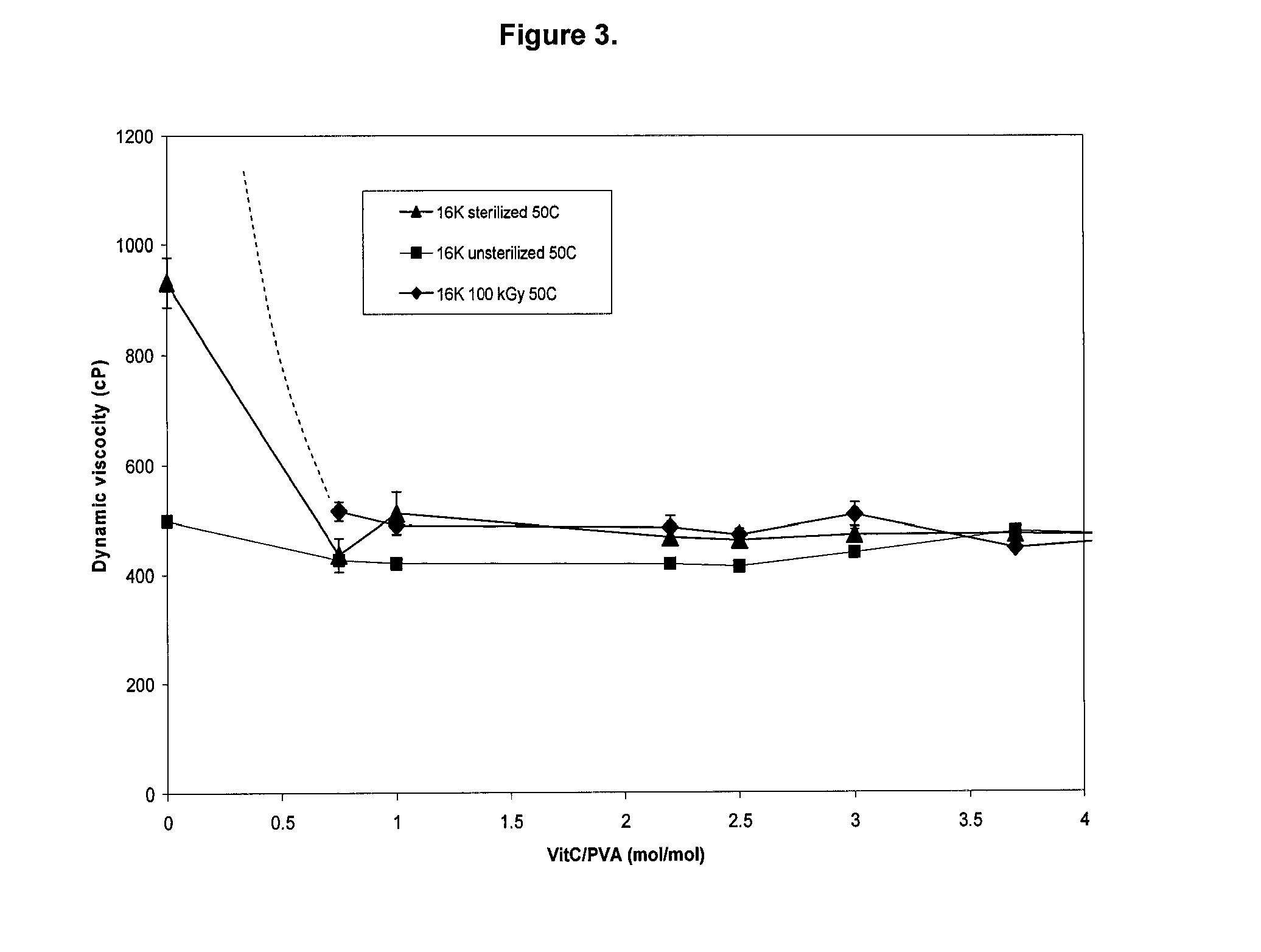Anti-cross-linking agents and methods for inhibiting cross-linking of injectable hydrogel formulations
a technology of cross-linking agents and injectable hydrogel formulations, which is applied in the direction of mixing, transportation and packaging, bandages, etc., can solve the problem of compromising the injectability of the hydrogel formulation
- Summary
- Abstract
- Description
- Claims
- Application Information
AI Technical Summary
Benefits of technology
Problems solved by technology
Method used
Image
Examples
example 1
Preparation and Irradiation of a PVA Solution by Ionizing Radiation
[0124]A 17.5 wt / v % of polyvinyl alcohol (PVA, Molecular weight=115,000 g / mol, Scientific Polymer Products, Ontario, N.Y.) was prepared by dissolving PVA in deionized water at 90° C. by constant stirring. The solution was kept at 90° C. in an air convection oven for 6 hours for degassing.
[0125]At this molecular weight of PVA and at this PVA concentration, the solution was very viscous at 90° C.
[0126]For sterilization, the solution that was kept in the oven was poured into 10 cc disposable syringes (Terumo Corp, Tokyo, Japan) that were pre-heated to 90° C. They were covered with Parafilm® and packaged in vacuum (Rival Products, VS110-BCD, El Paso, Tex.). These syringes were gamma irradiated to 25 kGy and 100 kGy (Steris, Northborough, Mass.). Controls were unirradiated.
example 2
Measurement of Viscosity by Using Bubble Tubes
[0127]The viscosity of unirradiated and irradiated PVA solutions were determined by using bubble tubes (Fisher Scientific). This method was appropriate because of the very high viscosity of the solutions. The bubble tubes were calibrated with viscosity standards (N100, D5000, S8000, N15000, Koehler Instrument Company, Bohemia, N.Y.).
[0128]Liquid samples were poured into the bubble tubes slowly without the formation of bubbles until the fill line. The cork cap was tightly fitted and the entire tube was vacuum packaged in a plastic pouch to prevent the sample from leaking. Then the samples were placed in a water bath at 50° C. or 100° C. The tubes were inverted and reverted. The time that it took the bubble volume between the two designated lines to travel 10 cm was recorded (between the bottom and first top lines). At least 6 measurements were done for each sample by two different observers.
example 3
Viscosity of Unirradiated PVA Solutions and Gel Content of Irradiated PVA Solutions
[0129]PVA solutions were prepared at a concentration of 17.5 wt / v % in deionized water as described in Example 1. Four different molecular weights of PVA were used: 16,000; 61,000; 86,000; and 115,000 g / mol. These solutions were poured into pre-heated syringes at 90° C. and packaged in vacuum. The syringes were then gamma irradiated to 25 kGy.
[0130]Pure PVA solutions were viscous but free flowing liquids at 50° C. The viscosities, as measured by using bubble tubes, were 498±3, 766±5, 5976±65, 17144±715 centiPoise (cP) for PVA molecular weights of 16K,000; 61,000; 86,000 and 115,000 respectively (see FIG. 2).
[0131]When these PVA solutions were irradiated to 25 kGy, only the solution containing PVA of molecular weight 16,000 g / mol was a liquid at 50° C. The viscosity of this solution was 931±45 cP. The sterilized PVA solutions containing higher molecular weight PVA than 16,000 g / mol did not flow at temp...
PUM
| Property | Measurement | Unit |
|---|---|---|
| temperature | aaaaa | aaaaa |
| temperature | aaaaa | aaaaa |
| temperature | aaaaa | aaaaa |
Abstract
Description
Claims
Application Information
 Login to View More
Login to View More - R&D
- Intellectual Property
- Life Sciences
- Materials
- Tech Scout
- Unparalleled Data Quality
- Higher Quality Content
- 60% Fewer Hallucinations
Browse by: Latest US Patents, China's latest patents, Technical Efficacy Thesaurus, Application Domain, Technology Topic, Popular Technical Reports.
© 2025 PatSnap. All rights reserved.Legal|Privacy policy|Modern Slavery Act Transparency Statement|Sitemap|About US| Contact US: help@patsnap.com



